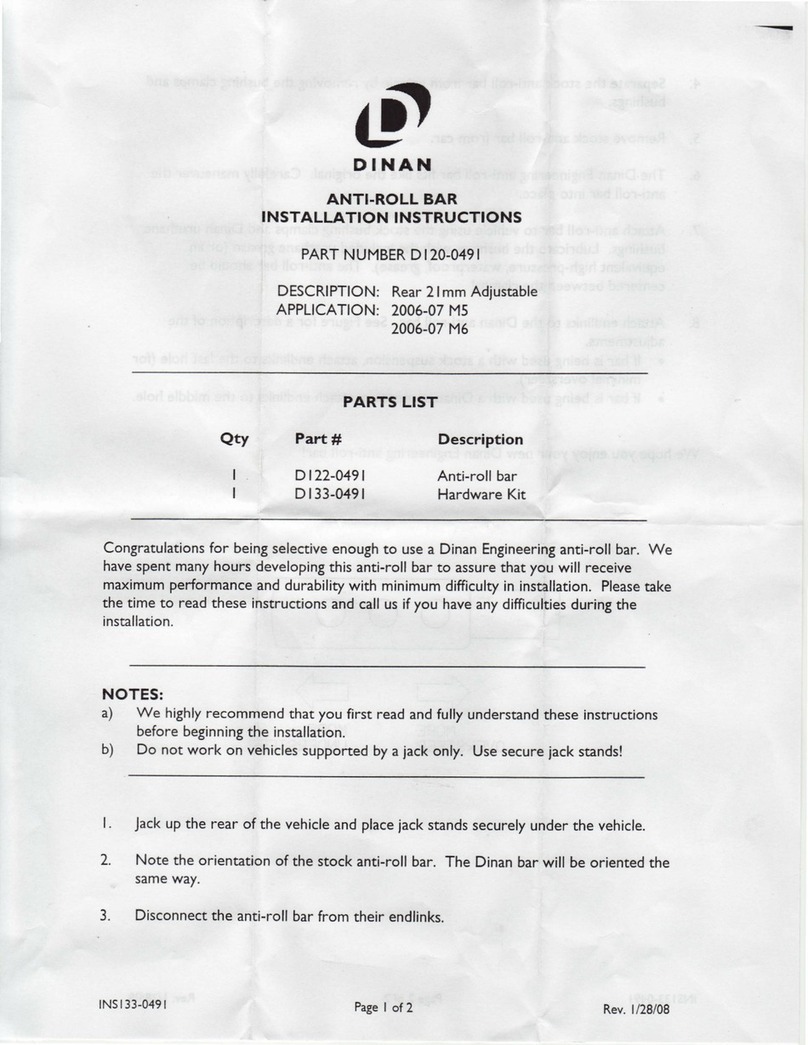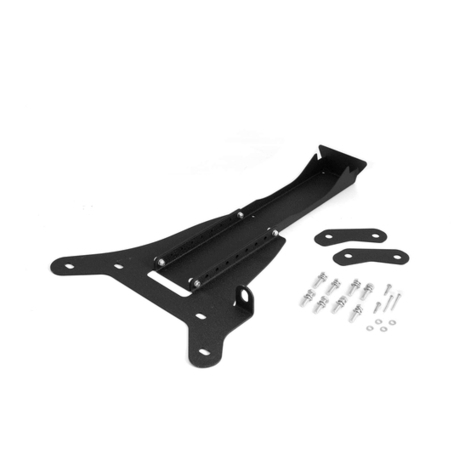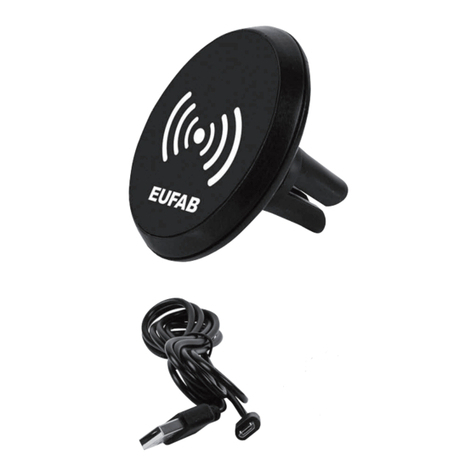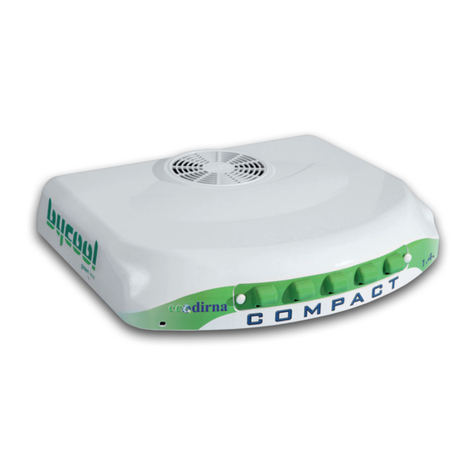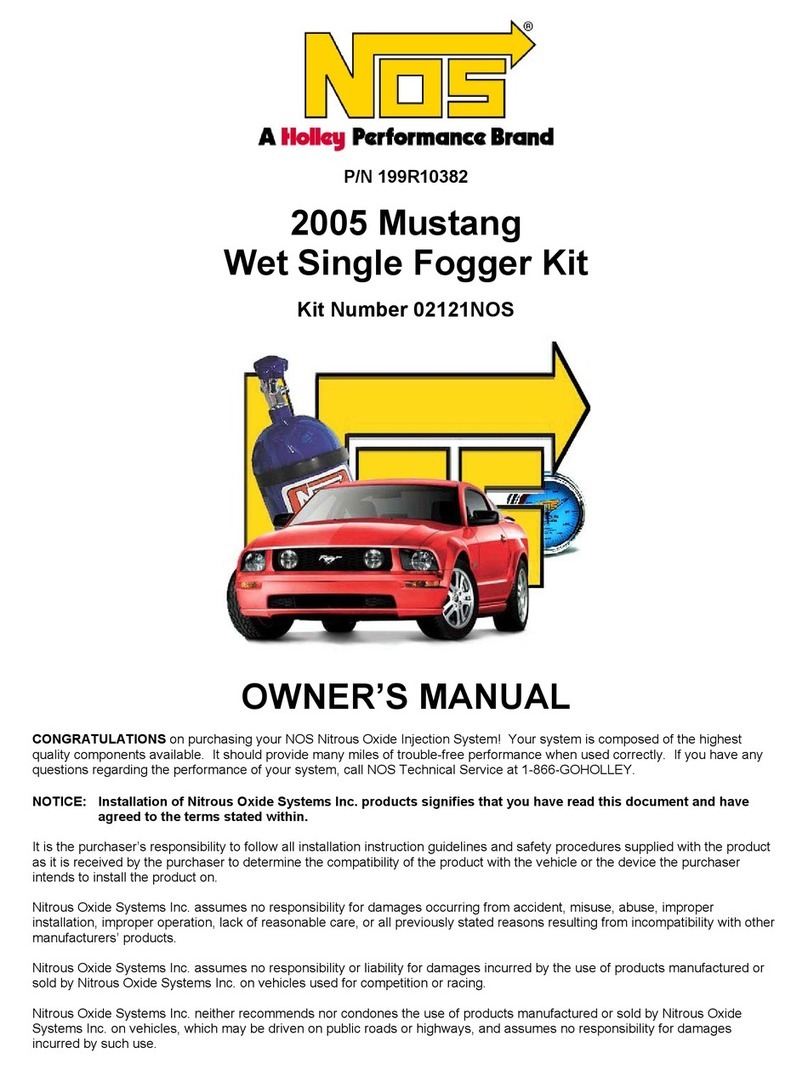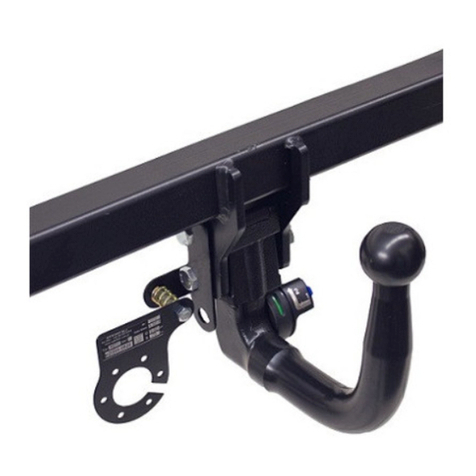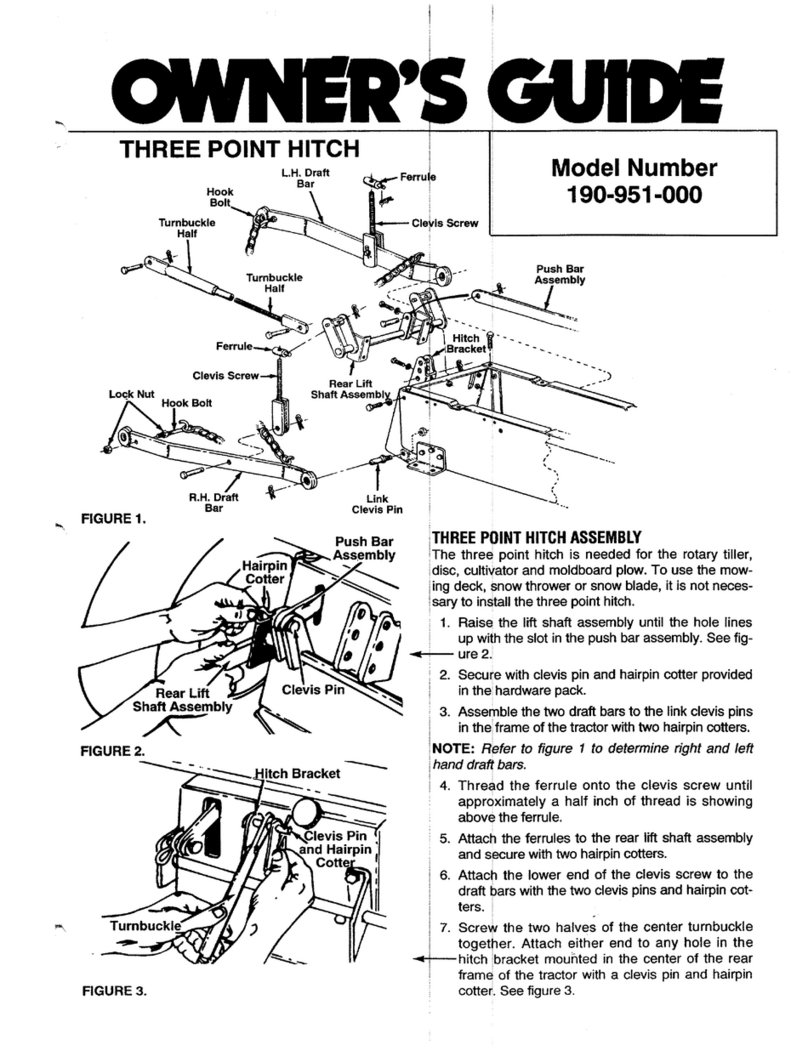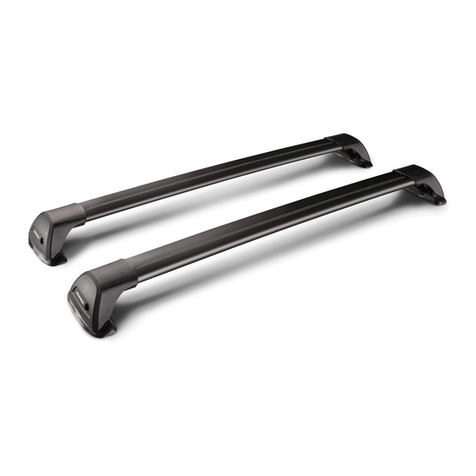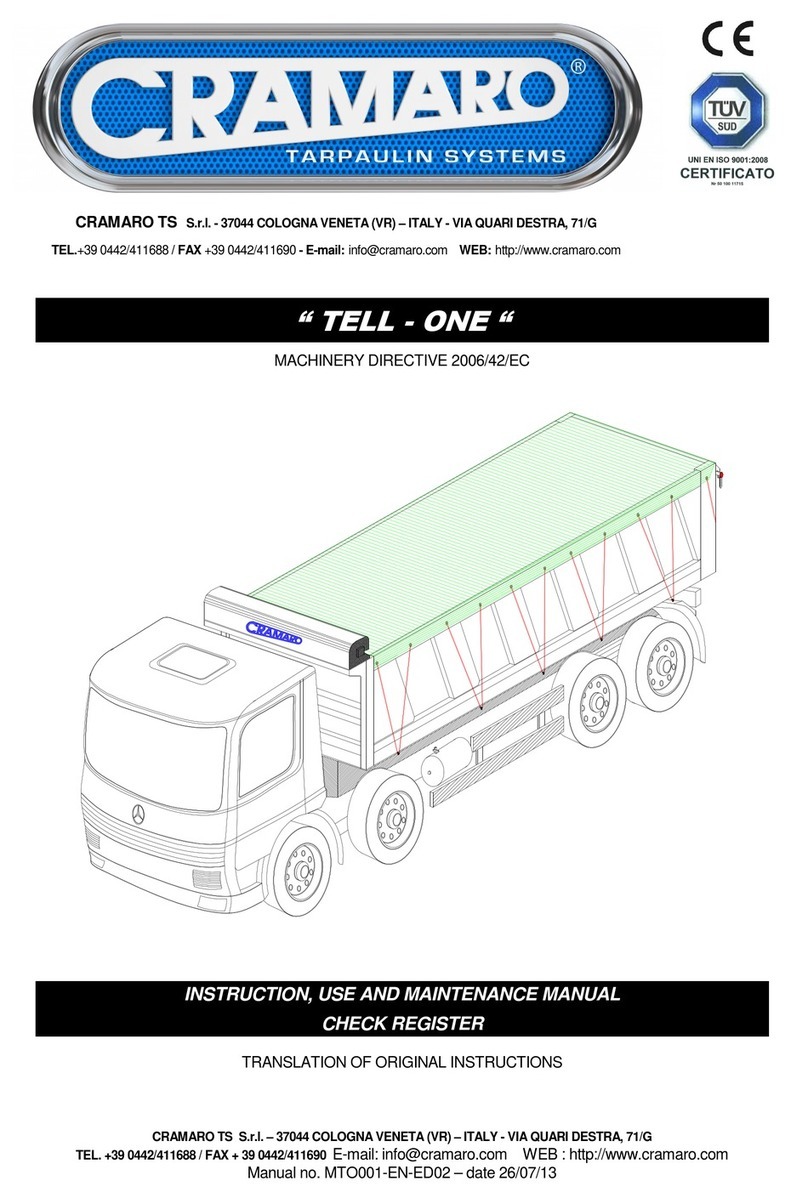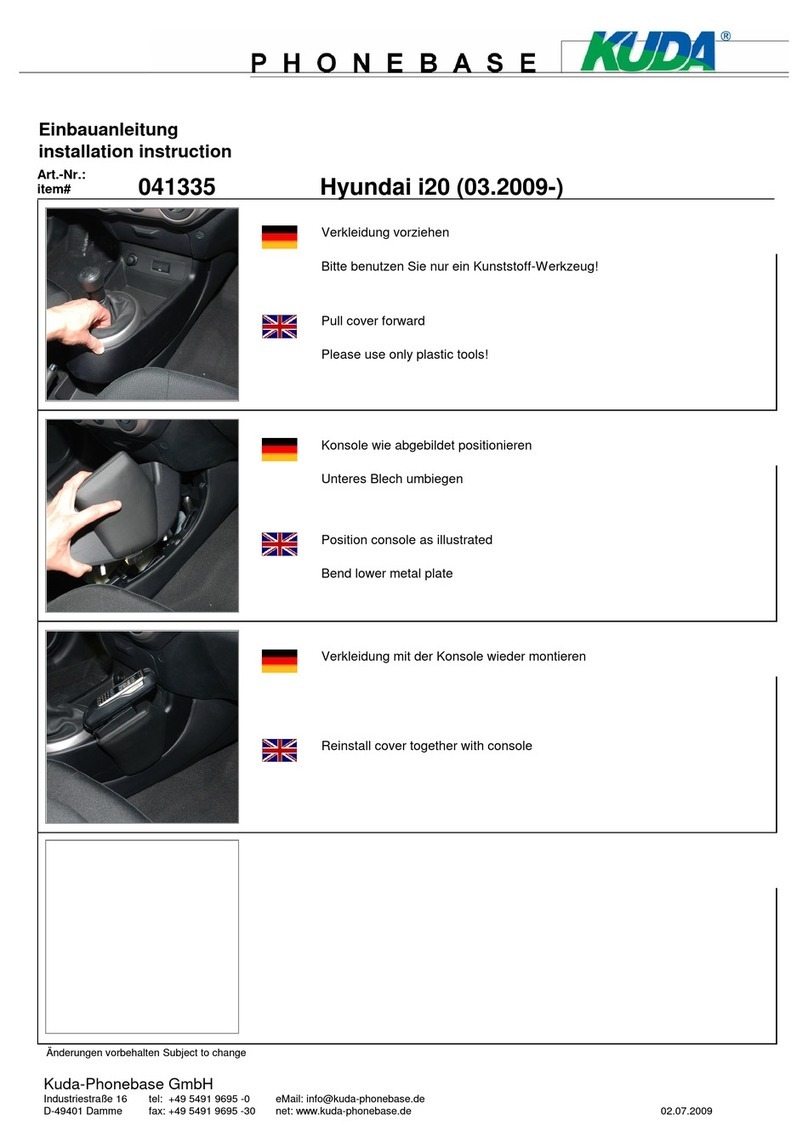Firstech, LLC. CM6000 User manual

Version 6.07

CM6000 Install Guide
Alarm and Starter System
www.firstechonline.com | www.compustar.com
Table of Contents CM6000
Copyright 2011 Firstech, LLC. Page 2
Introduction 4
Kit Contents 4
Installation Basics 5
Remote Programming Routine 6
Placement and Use of Components 6
Common Procedures 11
Wiring Descriptions 15
Option Programming Tables 22
Option Menu Descriptions 25
Special Option Groups 1 & 2 32
Option Programming 32
Troubleshooting 35
Frequently Asked Questions 36
Technical Support Contacts 38

CM6000 Install Guide
Alarm and Starter System
www.firstechonline.com | www.compustar.com
Copyright 2011 Firstech, LLC. Page 3

Introduction CM6000
CM6000 Install Guide
Alarm and Starter System
www.firstechonline.com | www.compustar.com
Thank you for purchasing this Firstech system for your vehicle. The following installation manual is intended
for experienced and authorized Firstech technicians. We highly recommend that you contact your local
Firstech dealer and seek professional installation. Call 888-820-3690 or visit our websites at www.
compustar.com to locate your nearest dealer. If you need additional or replacement remotes and/or online
support please visit www.compustar.com/dealersupport.
Caution: The Manufacturer’s warranty will be void if this product is installed by anyone other than an
authorized Firstech dealer. Firstech provides installation support services to authorized dealers only.
This manual may change frequently. Please check www.compustar.com/dealersupport for updates.
Kit Contents CM6000
All Firstech FT-6000AS CONT controllers include the following:
- CM6000 main control module
- Wiring diagram sheet
- Main ignition wiring harness with two external relays
- Wiring harnesses
- Hood pin
- Mountable bright blue LED
- Firstech dual stage shock sensor
RF Kits with remote(s), Antenna, and Antenna Cable are not included with the FT-6000AS CONT.
The following sensors are available but not included with every system:
- Remote pager sensor (FT-RPS TOUCH) or (FT-RPS-2)
- Secure valet switch (FT-VALET GREY)
- Thermister temperature sensor (FT-TEMP SENSOR) (Drone and 2 Way remote LCD systems)
- DAS sensor (FT-DAS)
The remote(s) and antenna are modular and are not specific to the control modules. You have the ability
to pair almost any Firstech remote(s) and antenna receiver to the CM6000. This includes all 4 and 6 pin
antennas.
Any questions on contents please contact your distributor or us directly at 1.888.820.3690, Monday
through Friday, 8 AM to 5 PM Pacific Time.
Copyright 2011 Firstech, LLC. Page 4

CM6000 Install Guide
Alarm and Starter System
www.firstechonline.com | www.compustar.com
Installation Basics CM6000
If you are new to installing Firstech Series Remote Starts and/or Alarms, we highly recommended that you
thoroughly review this manual to installing your first unit.
Key Points to Consider Before Installation:
You must code remotes to this system before anything will function. Program remotes by cycling the ignition
ON / OFF five times within seven seconds and press and release button 1 (half second) on the first remote,
and then press and release button 1 (half second) on the second remote.
RPS Touch (Touch Remote Paging Sensor):
The optional RPS that has four main functions; (1.) Status LED, (2.) Remote notification when triggered, (3.)
Auto unlock/alarm disarm when a user specific 4 digit knock code is entered via tapping sensor through the
windshield. (4.) You can also relock your vehicle if equipped with an RPS Touch sensor.
DAS Sensor:
The DAS sensor monitors forward movement for remote starting manual transmissions, dual stage impact,
and auto adjusting tilt sensor. See the DAS Sensor section of this manual for details.
Internal green/white loop must be cut for AUTOMATIC transmission vehicles.
By default, the units come in MANUAL transmission mode. You will need to cut the green/white loop inside
the control module if you are installing the unit in a AUTOMATIC transmission.
Tach learning procedure:
Learn tach by: (1.) Starting the vehicle with the key, (2.) Press and hold the foot brake, then (3.) Activate the
remote start sequence - one chirp and parking light flash indicates that the vehicle tach signal has been
successfully learned. Three chirps and three parking light flashes indicate that the control module failed to
see a proper tachometer signal. (These units have the option for Tachless and 1.5 second assume cranking).
New Option Menus:
It is important to familiarize yourself with all the options as it will save time in most applications. For in-
stance, Option 1-04 controls the double pulse unlock feature on all CM6 series control modules.
Programmable Output Channel (POC) Must have Option Programmer OP500
All control modules come with 9 programmable outputs that can be configured 19 different ways. It is
important to familiarize yourself with the POCs as it will save time in most applications.
Internet updatable processors Visit www.firstechonline.com
All CM6 series units are equipped with some of the most powerful processors available today. This flexibility
allows for on-demand internet updating capabilities in the event of a version update or change.
Copyright 2011 Firstech, LLC. Page 5

Remote Programming Routine CM6000
CM6000 Install Guide
Alarm and Starter System
www.firstechonline.com | www.compustar.com
IMPORTANT: Any and all remotes must be coded to the control module prior to performing any and all
operations.
STEP 1: Activate programming mode by manually turning the vehicle’s key between the Ign On and Off
(or the Acc & On positions) five times within 7 seconds. The vehicle’s parking lights will flash once with the
successful completion of this step. (Note: this step also places the control module into Valet Mode)
STEP 2: Within a 2 second period after the 5th ignition cycle tap Button I on two way remotes or the Lock
button on one-way remotes for a half second. The parking lights will flash once to confirm the transmitter
has been coded. Repeat for additional remotes, up to three.
Exiting Programming: Programming is a timed sequence. After 2 seconds
the parking lights will flash twice signaling the end of programming mode.
Programming Multiple Remotes: After the confirmation flash given in STEP
2, code additional remotes by tapping Button I on two way remotes or
the Lock button on one way remotes. The parking lights will flash once
confirming each additional remote. All systems can recognize up to three
remotes.
Note: If you do not program any remotes and enter this
sequence it will put the system into Valet Mode. Only the
keyless entry will work in Valet Mode. To exit Valet Mode just program
remote(s).
Copyright 2011 Firstech, LLC. Page 6
IMPORTANT: The placement and use of components are critical to the performance of this system.
Antenna and Cable
Firstech antennas are calibrated for horizontal installation at the top of the windshield. The cable that con-
nects the antenna to the control module must be free from any pinches or kinks. Installing the antenna in
areas other than the windshield may adversely affect the effective transmitting distance of the remotes.
Placement and Use of Components CM6000

CM6000 Install Guide
Alarm and Starter System
www.firstechonline.com | www.compustar.com
Placement and Use of Components CM6000
RPS Touch and RPS (Remote Paging Sensor)
The RPS is an optional feature. The car call/RPS feature uses a small sensor that is mounted on the inside of
your windshield. Important: When using the RPS Touch, you cannot use the LED port or Secure Valet Switch.
RPS Touch (Remote Paging Sensor)
The new RPS touch has multiple features including: remote paging, 4 digit pin unlock/disarm, and arm/
lock. All features are operated with a simple touch of the sensor.
Please program Option 3-16 to Setting 2.
RPS Touch and car call functions do not require programming, however in order to unlock/disarm your ve-
hicle you must program a 4 digit passcode (numbers 1 through 10 only) using the instructions below:
STEP 1: Choose your RPS Touch 4 digit code. ‘0’ is not available.
STEP 2: Turn ignition to the ‘ON’ position and leave driver’s door open.
STEP 3: Hold your finger over the ‘Red Circle’ icon for 2.5 seconds.
STEP 4: When the siren chirps and LEDs flash in a circular pattern, tap on your first number. (Hold the
number for 2.5 seconds to choose 6 through 10.) After choosing your first number you will get one siren
chirp and LEDs will flash in a circular pattern.
STEP 5: Repeat Step 4 until all four digits are set. You will get 1 siren chirp and 1 parking light flash. Re-
peat Steps 2 - 5 if you get 3 chirps and light flashes. Your RPS Touch is now programmed.
Alarm rearm and lock
To rearm hold your finger on the ‘Red Circle’ for 2.5 seconds.
Alarm disarm and unlock
To disarm hold your finger over the ‘Red Circle’ for 2.5 seconds. Once the LEDs start their circular pattern,
enter your 4 digit code. (Refer to Step 4 above.) Two seconds after entering the 4th digit, your system will
disarm.
Copyright 2011 Firstech, LLC. Page 7

2 Way LCD remote paging
To page a 2 Way LCD remote just tap the ‘Red Circle’ twice.
Touch Panel Sensitivity
To change touch sensitivity open the driver’s door, hold the button on the back of the RPS Touch until the
LEDs go out. Release button and tap again. The number of solid LEDs represent sensitivity of touch, 1 being
the lowest, 5 the highest.
RPS Touch On or Off
You can turn the RPS Touch off from your remote. Just follow the instructions below:
STEP 1: Enter remote programming mode by holding down buttons 2+3 (Trunk and Key/Start buttons on
2W901R-SS) simultaneously for 2.5 seconds. The remote will beep once and the LCD or read “REMOTE
MENU” indicating that you have entered programming mode.
STEP 2: Scroll through the remote options by taping button 3 or 4 (Function button 2W901R-SS). Once the
LCD RPS icon flashes reads “RPS-ON” tap button 1 or (Lock button 2W901R-SS) to turn this feature on. The
LCD will read “RPS-OFF”
STEP 3: Exit remote programming by holding down buttons 2+3 (Trunk and Key/Start 2W901R-SS)
buttons simultaneously for 2.5 seconds. The remote will beep indicating that you have successfully exited
programming.
RPS (Remote Paging Sensor) Unlock/Disarm
RPS and car call functions do not require programming, however in order to unlock/disarm your vehicle you
must program a 4 digit passcode (numbers 1 through 10 only) using the instructions below:
STEP 1: Disarm/unlock the alarm (remote must be programmed first) and choose a 4 digit code. You can
not have zeros.
STEP 2: Turn ignition key to the “on” position and leave the driver’s door open.
STEP 3: Knock on the windshield in front of the RPS a total of 5 times (each time you knock the LED on the
RPS will flash RED). The LED will begin to flash rapidly in BLUE with successful completion of this step.
STEP 4: Enter the first digit of the desired four digit pass code by knocking on the windshield in front of
the RPS the desired number of times. For example, to enter 3, knock on the sensor 3 times (each time you
knock the LED will flash RED) then wait.
CM6000 Install Guide
Alarm and Starter System
www.firstechonline.com | www.compustar.com
Placement and Use of Components CM6000
Copyright 2011 Firstech, LLC. Page 8

STEP 5: The LED on the RPS will confirm your first number by flashing BLUE slowly. Once the LED begins to
flash rapidly in BLUE, enter your second number by repeating step 4.
STEP 6: Repeat steps 4 & 5 to enter all four numbers.
STEP 7: Turn the ignition OFF - the RPS disarm/unlock passcode is now programmed. Follow steps 3 – 5
to enter your disarm/unlock code.
Alarm rearm and lock
To rearm, knock on your sensor 5 times.
Alarm disarm and unlock
To disarm, knock on your sensor 5 times. Wait for the Blue LEDs to flash rapidly. Follow STEP 4 and 5 above
to enter your 4 digit passcode.
2 Way LCD remote paging
To page a 2 Way LCD remote just knock on the RPS twice.
Knock Panel Sensitivity
To change knock sensitivity, disarm the system and adjust the switch on the rear of the RPS. The larger the
circle, the more sensitive the knock sensor is.
Secure Valet Switch (Not available when using RPS Touch)
The optional Secure Valet Switch prevents the alarm from being put into valet mode through cycling the igni-
tion on/off five times. The Secure Valet Switch is more secure than traditional toggle / valet switches because
it requires a two digit code. To program this feature you must perform the following procedures:
STEP 1: Turn on Option 3-10-III.
STEP 2: Turn ignition key to the “on” position.
STEP 3: Hold down the valet switch for 1.5 seconds. The LED on the valet switch will begin to flash rapidly
with successful completion of this step.
STEP 4: Enter the first digit of the desired two-digit pass code by depressing the switch the number of times
that coordinates with the desired first number. For example, to enter 3, depress the switch 3 times, then wait.
STEP 5: The LED will confirm the first number by flashing BLUE slowly. Once the LED begins to flash rapidly,
enter your second number by repeating step 4.
STEP 6: Turn the ignition off - the Secure Valet Switch is now programmed. Follow steps 3 – 5 to enter your
Secure Valet code.
**The first two digits of the RPS unlock/disarm pass code will be the default pass code
for the Secure Valet (you do not need to program them independently).
CM6000 Install Guide
Alarm and Starter System
www.firstechonline.com | www.compustar.com
Copyright 2011 Firstech, LLC. Page 9

Placement and Use of Components CM6000
CM6000 Install Guide
Alarm and Starter System
www.firstechonline.com | www.compustar.com
Copyright 2011 Firstech, LLC. Page 10
The DAS sensor monitors forward movement for remote starting manual transmissions, dual stage impact,
and auto adjusting tilt sensor. Follow the steps below to properly setup your DAS sensor.
Installing Your DAS
STEP 1: Set Option 4-12 to Setting 2
STEP 2: Set switch 1 and 2 on the side of the DAS. *See below for explanation or switches.
STEP 3: Connect cable to the red 4 pin port on the CM6 Series module.
STEP 4: Mount DAS securely using zip ties or included hardware. Can be mounted in any orientation. Tilt
will set 30 seconds after arming.
Adjusting DAS Shock Sensitivity (CM6000 or CM6300)
STEP 1: Turn the ignition to the ‘on’ position.
STEP 2: 2 Way remotes-hold buttons 1 and 2 (Lock and Unlock) for 2.5 seconds. You will get two parking
light flashes. 1 Way remotes-hold Lock and Unlock for 2.5 seconds. You will get two parking light flashes.
STEP 3: To set the Warn Away Zone 1, tap button 1. (1 Way: Lock) After you get one parking light flash,
tap the vehicle. You will get siren chirps 1-most sensitive through 10-least sensitive. This sets the impact
sensitivity of Warn Away Zone 1. Setting Zone 1 will automatically set Zone 2. If you would like
to manually set Zone 2 proceed:
To set Instant Trigger Zone 2, tap button 2. (1 Way: Unlock) After you get two parking light flashes, tap the
vehicle. You will get siren chirps 1-most sensitive through 10-least sensitive. This sets the impact sensitivity of
Instant Trigger Zone 2.
STEP 4: Once you get two parking light flashes, you are ready to test your DAS.
Testing The DAS Sensor
STEP 1: Turn the ignition off and Arm/Lock the system.
STEP 2: Wait 30 seconds then test the impact sensitivity.
Firstech Shock Sensor
For best results mount the shock sensor by zip tying it to the vehicles main ignition harness. You can also use
the supplied mounting hardware to mount your sensor. There is a small dial on the sensor that ranges from
Off to 10. The higher the number on the dial the greater sensitivity of impact. A small adjustment to the dial
can make a significant difference in sensitivity for both 1st and 2nd stages. Recommended dial settings for
most vehicles is somewhere between 2 & 4.
DAS Sensor
Switch 1: ON - 3 Degree Tilt Switch 2: ON - 4 Inch Movement
OFF - 1.5 Degree Tilt OFF - 3 Inch Movement

Common Procedures CM6000
Jumper Settings
Caution: Jumper settings affect the polarity and use of certain outputs. If these jumpers are used incorrectly,
damage to the vehicle and /or control module may occur.
Jumper 1 (Door Trigger Polarity)
Determines the polarity of the door trigger input wire (red/white). In the default position the door trigger
registers negative (-) triggers. To change to a positive (+) trigger, move the jumper.
Jumper 2 (Glow Plug or Key Sense Polarity)
Determines the polarity of the glow plug or key sense input wire (brown/white). In the default position it
monitors a positive (+) glow plug input. To change to a negative (-) input move the jumper. To change from
the glow plug to the key sense setting, you must change Option 4-09.
Siren
To adjust duration time when the alarm has been triggered, change Option 3-07 – the system default is 30
seconds.
Thermister (Temperature Sensor)
Every 2 Way LCD Firstech RF kit includes an optional thermister, which must be plugged into the 2 pin
port of the control module for use. This plug is blue on the CM6000. The use of the thermister allows the
2 Way remote to display the vehicle’s interior temperature on the remote LCD (liquid crystal display) as
well as permitting the vehicle to start with timed Hot or Cold starting; see options 2-05, 2-07 and 2-08.
IMPORTANT: Thermister plugs are blue 2 pin connectors on the CM6 series but thermisters with white
plugs will work.
Hood Pin
The hood pin switch triggers the alarm in the event the hood is opened while the alarm is armed. The hood
pin doubles as an important safety feature that prevents the remote start from engaging while the hood is
open.
Backup Battery
The backup battery input on the control module/brain is for optional battery backup unit (FT-BATT BACKUP). The red
positive lead (+) acts both as an input and charging output for a 12 Volt battery backup. A backup battery maintains
basic alarm functionality when main vehicle power is lost. See the wiring schematic section for complete details.
CM6000 Install Guide
Alarm and Starter System
www.firstechonline.com | www.compustar.com
Copyright 2011 Firstech, LLC. Page 11

CM6000 Install Guide
Alarm and Starter System
www.firstechonline.com | www.compustar.com
Jumper 3 (Parking Light or Trunk Output)
Determines the output type (not polarity) of the green/white wire on connector one (CN1). In the default
position it provides a positive (+) parking light output. To change to a positive (+) trunk output move the
jumper. A negative (-) parking light output is found on connector three (CN3) and a negative (-) trunk output
is found on connector four (CN4).
Setting Auxiliary Outputs on Connector 2
You Must Have the OP500 Option Programmer
To set auxiliary outputs on the control module involves the new Programmable Output Connector wires
(POCs). You must choose two odd pin wires on the black 18 pin connector that you are not using. For
example we will use POC 8 and 9.
STEP 1: Plug in OP500 and use the Right or Left Arrow Button to scroll through the menu to POC 8 and POC 9 on LCD Line 1.
STEP 2: Use the Up or Down Arrow Button to change the lower number on LCD Line 2 to 10 – Auxiliary 1 or 11- Auxiliary 2.
STEP 3: Scroll up the menu to Option 4-01 and 4-02 and set the options. Please see the Option Table for details.
STEP 4: The control modules have a secure auxiliary option 4-05. This requires you to tap button 4 before you tap button 2 for
Aux 1 or button 3 for Aux 2. On 1-Way remotes you must hold the Trunk and Key/Start buttons for 2.5 seconds then tap the Trunk
button for Aux 1 or the Key/Start button for Aux 2.
STEP 5: If you need to change the time settings of the outputs go to AU1 or AU2 on the OP500. LCD Line 2 is the timed output.
STEP 6: Hold the “W” Write button for 3 seconds to set all the options.
Tach Sensing
The default engine sensing mode is tach. In cold weather climates we recommend using an injector wire
verses a coil wire for tachometer sense. There are new features that adjust tach reading methods on option
2-01. IMPORTANT: The remotes must be coded prior to setting up tach sensing. Firstech recommends
using a digital multimeter to test for tach.
STEP 1: Start the vehicle with the key. Allow time for the engine to idle down.
STEP 2: Test wire and make connection. At idle the tach wire should test between 1 to 4 Volts AC. As the
vehicle RPM’s increase the voltage on the meter will also increase. Always solder tach connections.
STEP 3: Learn tach. While the vehicle is at idle, hold the foot brake and activate the remote start function
on the remote control for 2.5 seconds. The parking lights will flash once and the siren will chirp once to
confirm a good tach signal. The parking lights will flash two times and the siren will chirp two times to
indicate the tach did not learn. Two seconds
following the two flashes, the number of
parking light flashes will indicate the cause
of the error:
Number of
Parking Light
Flashes
Tach Error
1 Option 2-10 is not in default setting 1
2 Key is in the off position
3 Bad tach signal. Find a different wire.
Copyright 2011 Firstech, LLC. Page 12

CM6000 Install Guide
Alarm and Starter System
www.firstechonline.com | www.compustar.com
Alternator Sensing
Alternator sensing is an alternative method the remote start can utilize to determine if the engine is running.
This is different than the no tach sensing mode so a connection must be made. IMPORTANT: The remotes
must be coded prior to setting up alternator sensing.
STEP 1: Change Option 2-10 to setting 2 - Alternator sensing.
STEP 2: Test wire and make connection. The stator wire is found at the vehicle’s alternator. Change your
multimeter to DC voltage before testing for this wire.
A. At rest, with the ignition off, the stator wire should test 0V DC.
B. Turn the ignition to the run position. The stator wire should now test between 4 – 6V DC.
C. Start the vehicle with the key. The stator wire should now test between 12 – 14V DC at idle.
STEP 3: Process complete – no further programming is required.
Tachless Mode – (Automatic Transmission Vehicles Only)
Tachless sensing is an alternative engine sensing mode. It does not require a connection to the vehicle other
than the main ignition harness.
STEP 1: Change Option 2-10 to setting 3 – Tachless Mode.
STEP 2: Process complete – there is no further programming required other than adjusting crank time
when necessary (see below).
Adjusting Crank Time: To adjust minimum crank times, refer to Option 2-12. To help ensure successful
starting, the system will automatically add additional crank time to the 2nd and 3rd start attempts. In
addition, there is a built in “Smart Resting Mode”. Traditional tach sensing is still highly recommended for
colder climates.
Timed Crank Setting – Automatic Transmissions Only
Option 2-10 setting 4 provides a timed 1.5 second crank for the remote start sequence. This option just
cranks the vehicle for 1.5 seconds and assumes remote start has completed. This option can be used for
GM and other vehicles with built in anti-grind systems.
Green/White Loop
This loop wire determines the transmission setting. The default position (uncut loop) is for manual
transmissions. When the loop is cut, the system will be ready for automatic transmissions. In the default
(manual transmission) mode, the system must be set up in Reservation mode prior to the vehicle being able
to remote start. IMPORTANT: All warranties or claims are void if a controller with a cut loop is installed on
a vehicle with a manual transmission.
Reservation Mode for Manual Transmissions
To remote start a manual transmission vehicle, the system must first be set up in reservation mode.
Reservation mode is designed to prevent the vehicle from remote starting while the transmission is in gear.
Copyright 2011 Firstech, LLC. Page 13

CM6000 Install Guide
Alarm and Starter System
www.firstechonline.com | www.compustar.com
Installation Requirements
1. The vehicle’s door triggers must be connected to the control module. Prior to making final connections,
test the factory door triggers to ensure that they are functioning properly.
2. The vehicle’s emergency/parking brake wire must be connected to the control module. The proper ve-
hicle wire usually provides a negative (-) trigger while the emergency / parking brake is set.
3. The vehicle’s clutch must be temporarily bypassed while the remote start cranks the engine. This bypass
simulates the clutch being depressed. For complete details on how to wire a momentary clutch bypass con-
sult your CompuTech program or contact our technical support department by calling 888-820-3690.
IMPORTANT: Do not install a remote start in manual transmission vehicles with convertible / removable
tops and in user’s vehicles that leave their windows down. Firstech nor their authorized dealers will assume
responsibility for improper use or install.
Activating Reservation Mode
STEP 1: Start the vehicle with the key. Place the transmission in neutral, remove pressure from the pedal
brake, and set the emergency/parking brake.
STEP 2: Remove the key from the vehicle’s ignition. The vehicles engine should remain running even after
the key has been removed. If the vehicle does not remain running, check the emergency / parking brake
connection and your tach connection.
STEP 3: Exit the vehicle and close the door. The vehicle’s engine should shut off upon closing the door. If
the vehicle’s engine does not shut off, check the door trigger connection or wait for the factory dome-light
to go out. The Firstech system is in reservation mode and the vehicle is ready to safely remote start.
Additional Notes
Reservation mode will be cancelled if the control module recognizes the vehicles door, hood or trunk
opening – or if the alarm is triggered. Each time the end user wants to remote start their manual
transmission vehicle, they must set the control module in reservation mode. Reservation mode settings can
be programmed with Option 1-06.
Version Diagnostics
All the new control modules come with the ability to check which firmware is on the module. This is
accomplished by turning the ignition on. Then with 2 Way remotes you must hold buttons 1 and 4 together
for 2.5 seconds. With the 1 Way remotes you must hold the Lock and Key/Start buttons together for 2.5
seconds. Current version starts with 1 flash.
Blade Cartridge Slot and Connector
CM6000, CM6200, and CM6300 slot gives you the ability to use the Blade-AL and Blade-TB modules from
Firstech and ADS. With these modules you can virtually eliminate all wire connections between your control
module and bypass module. You only need to connect the main ignition harness and your needed wires on
the 20 pin Blade connector. For more information on how to program and wire the Blade please visit www.
idatalink.com for the specific wiring diagram for that vehicle.
Copyright 2011 Firstech, LLC. Page 14

CM6000 Install Guide
Alarm and Starter System
www.firstechonline.com | www.compustar.com
The CM6 Series Blade connector has a locking tab. Non-locking tab blade harnesses will work
but you MUST TAKE CARE TO NOT PLUG THE HARNESS IN UPSIDE DOWN. Make sure the two
notches on the top of the harness face the top (CM and barcode sticker side) of the brain. When looking at
the wire side of the harness the two notches must be at the top of the plug.
Blade system includes:
1. Blade-AL or Blade-TB (NOTE: These modules are blank and must be flashed on your computer.)
2. 20 Pin locking wiring harness
3. 3 Pin harness used in some installs
IMPORTANT: Install diagrams are not included and must be downloaded from www.idatalink.com/
compustar. When flashing the Blade you can use the Y-Cable OP500 end and not CM4 Series end. ADS
and Firstech recommends using the 4 pin RS232 cable to avoid confusion. Cartridge must be removed to
flash the control module firmware when not using www.idatalink.com.
NOTE: The ADS-RNG C1, ADS-RNG C2, and ADS-RNG GM3 are not included and must be purchased
separately. The 20 pin Blade connector comes only with the Blade cartridge and not the CM6 control
modules.
WARNING: Manufacturer or seller assumes no responsibility for any injuries and/or damages caused by
improper care of the product such as decomposition, conversion, and transform done by a user voluntarily.
WARNING: There should be no wiring routed around any pedals which can cause a driving hazard.
Wiring Descriptions CM6000
Connector 1 (CN1), 6-Pin
Pin 1 White – Accessory 12V positive (+) output. This wire must be connected to the vehicle accessory
/ HVAC blower motor wire. The proper wire will test 0V with the key in the off position, (+) 12V
while key is in the on position, 0V while cranking and back to (+) 12V when the key is returned to
the on position. This wire has a 25 amp fuse on it.
Pin 2 Yellow - Starter 12V positive (+) output. This wire is pre-wired to Pin 87a of the anti-grind/starter-kill
relay. This wire must be connected for remote start. The proper wire will test 0V with the key in the off
position, 0V while the key is in the on position and (+) 12V during crank.
Copyright 2011 Firstech, LLC. Page 15

CM6000 Install Guide
Alarm and Starter System
www.firstechonline.com | www.compustar.com
There are two wires coming off of the relay; yellow/black and yellow. To utilize the anti-grind or
starter- kill features, the vehicles starter wire must be cut in half, otherwise, cut the relay out of the
harness and connect the yellow (Pin 6) directly to the vehicles’ starter wire. The starter kill/anti grind
relay has a thin 24 guage blue
wire. This must be connected to
pin 1 (24 guage blue wire) on
Connector 3.
IMPORTANT: For anti-grind and
starter-kill applications, the yellow wire
goes to the starter side of the vehicles
starter wire and the yellow/black goes to
the key side.
Pin 3 Green – Ignition 12V positive (+)
output and input. This wire must be
connected to the vehicle’s ignition
for remote start and valet/program
ming. The proper wire will test 0V
with the key in the off position, 12V
(+) while the key is in the on posi-
tion and 12V (+) during crank. This
pin also has a thin green wire that is
prewired to the starter kill relay. If you are not installing anti grind/starter kill, you do not need to
connect the thin 24 guage green wire.
Pin 4 Black - Ground negative (-) input. This
wire must be connected to the vehicle’s
ground.
Pin 5 Red - Constant 12V positive (+) power
input. These two wires must be con
nected. The proper vehicle wire will test
(+) 12V at all times while the key is
in the off position, the on position and
during crank. Each wire has a 30 amp
fuse on it. An optional relay with a 14
guage red wire and 30 amp fuse is for
secondary ignition/accessory/starter
wires. The short violet wire on Pin 85
is the trigger input wire that determines
the (+) 12V output type of the long
blue wire on Pin 30. For example, connecting the negative (-) Ignition output from Connector 3, to
the short violet wire coming off of the relay, will provide an additional (+) 12V Ignition output from
the long blue wire.
Copyright 2011 Firstech, LLC. Page 16

CM6000 Install Guide
Alarm and Starter System
www.firstechonline.com | www.compustar.com
Connector 2 (CN2), 2-Pin: Optional Battery Back-up
Pin 1 Red - Constant 12 V positive (+) input and (+) charging output.
Pin 2 Black - Ground (-) negative input.
Connector 3 (CN3), 20-Pin: Programmable Output Channel (POC)
IMPORTANT: Odd Pin numbers 3 through 19 are programmable for up to 19 different output types.
Refer to Special Option Group 2 for complete details.
Pin 1 Blue - 250mA negative (-) output when armed and during remote start (while running). This wire is
pre-wired to the anti-grind/starter-kill relay. Caution: When this wire is being used to trigger
aftermarket accessories it must be diode isolated.
Pin 2 Orange/Black - Parking Light Reminder (-) input that monitors the vehicle’s parking lights.
Pin 3 Green/White [POC 1] - Parking light 250mA negative (-) output. The proper wire will test (-) when
the parking light switch is in the on position.
Pin 4 Light Blue – Parking / Emergency brake negative (-) input. This input is required for manual
transmission/reservation and turbo-timer mode. The proper wire will provide a (-) trigger when
parking / emergency brake is set and ignition is on.
Pin 5 Red/Black [POC 2] – 2nd Starter 250mA negative (-) output. This output provides a negative (-)
trigger output during remote start crank.
Pin 6 Light Blue/White - Brake 12V positive (+) input. This input must be connected as it provides a shut
down for the remote start. The proper wire will test (+) 12V while the foot brake is pressed.
Pin 7 Green [POC 3] - 2nd Ignition 250mA negative (-) output. This output provides a negative (-) trigger
upon remote start, throughout the crank and during remote start.
Pin 6 Green/White – This is a dual-purpose wire that features selectable functionality thru the parking
light/trunk output jumper on the control module. It is either a positive (+) parking light output or
positive (+) trunk output. This wire carries a 10 amp fuse.
Default - Parking light positive (+) output. The proper vehicle wire will test (+) 12V when the parking
light switch is in the on position.
Optional – Trunk release positive (+) output. The proper vehicle wire will test (+) 12V when the trunk
release is triggered.
Copyright 2011 Firstech, LLC. Page 17

CM6000 Install Guide
Alarm and Starter System
www.firstechonline.com | www.compustar.com
Pin 8 Violet/Black - Trunk negative (-) input. This is an optional input that will monitor when the vehicle’s
trunk has been opened. The proper wire will provide a (-) trigger while the trunk is open.
Pin 9 White/Black [POC 4] - 2nd Accessory 250mA negative (-) output. This output provides a negative (-)
accessory trigger that will drop out during crank.
Pin 10 Red/White - Door trigger input. This wire monitors negative (-) or positive (+) trigger door-pins. The
proper wire will provide a (-) trigger or a (+) trigger only when the doors are opened. You will need
to test the wire for proper polarity and set the jumper on the control module for the corresponding
polarity. IMPORTANT: This wire is required for manual transmission remote starts.
Pin 11 Black [POC 5] – Status/Ground while running 250mA negative (-) output. This is an optional output
that will provide a negative (-) output before the ignition turns on and stays on throughout the remote
start duration. This wire is most commonly used to trigger bypass / transponder modules.
Pin 12 Brown/White - This is a dual-purpose wire that is selectable through Option 4-09 in the
programming table. Select the polarity through the glow/key jumper on the control module. It can be
set to accept either a positive (+) or negative (-) wait to start input / key sense.
Default – Glow plug positive (+) or negative (-) input. The proper vehicle wire will show a (+) or (-) trigger while the wait
to start light is on. This wire will delay the starter output momentarily to allow the glow plugs to warm up on vehicles
equipped with a diesel engine. You can adjust the remote start delay with Option 2-03 and the FT-OP500-KIT.
Optional – Key sense positive (+) or negative (-) input. The proper wire will show a (+) or (-) trigger only when the key is
in the ignition. The purpose of the key sense is to prevent the system from passively arming or setting reservation mode
while the key is still in the ignition.
Pin 13 Orange [POC 6] - Factory Arm 250mA negative (-) output. This is an optional output that will
provide a (-) pulse during lock, after crank and again after the ignition shuts down.
Pin 14 Pink - Slave/Closed Loop negative (-) input. This is a dual-purpose optional input that can be
changed through Option 4-10.
Default: Slave/Timer Start (-) input. This is most commonly used when adding a remote start to a
factory keyless entry system. You can adjust the number of pulses with Option 2-04.
Optional: Closed Loop (-) input. This wire acts as an instant trigger when separated from ground (-).
It is most commonly used to protect headlights or trailers.
Pin 15 Orange/White [POC 7] - Factory Disarm 250mA negative (-) output. This optional output will
provide a (-) pulse during unlock and prior to the ignition turning on. It is typically used to disarm
factory security systems.
Pin 16 Yellow/Black - Engine sensing input. This wire is connected to the vehicles Tach or Alternator wire
and is required if you are not using the no tach sense setting. IMPORTANT: To change engine-
sensing modes, you must change Option 2-10; Default requires a Tach input.
Copyright 2011 Firstech, LLC. Page 18

CM6000 Install Guide
Alarm and Starter System
www.firstechonline.com | www.compustar.com
Pin 17 White [POC 8] - Horn honk 250mA negative (-) output. This is an optional output that will pulse the
factory horn. The proper wire will show ground (-) while the horn is sounding. To change horn
output settings, review Options 3-08 and 3-09.
Pin 18 Gray/Black – Hood Pin negative (-) input. This input is a safety shut down and alarm trigger. It
prevents the vehicle from remote starting while the hood is open and triggers the alarm if the hood
is opened while the alarm is armed. You can connect this wire to the hood pin supplied with this kit,
or to a wire in the vehicle that shows (-) only while the hood is open.
Pin 19 Violet [POC 9] - Auxiliary 1 - 250mA negative (-) output. This is an optional output that will provide
a pulsed, latched, or timed negative output when triggered by the remote(s). This can be used for
power sliding doors, window modules or other outputs.
Pin 20 Brown - Siren 12V positive (+) output. Connect this wire to the (+) wire located on the siren. To
change siren output settings, review Option 3-7.
Connector 4 (CN4) , 20 Pin Blade Connector - New Generation
This connector is used only if you are installing a Blade-AL or Blade-TB. The wiring harness for this
connector only comes with the Blade cartridge. Please refer to the Blade install guide for wire description.
The CM6 Series Blade connector has a locking tab. Non-locking tab blade harnesses will work
but you MUST TAKE CARE TO NOT PLUG THE HARNESS IN UPSIDE DOWN. Make sure the two
notches on the top of the harness face the top (CM and barcode sticker side) of the brain. When looking at
the wire side of the harness the two notches must be at the top of the plug.
Connector 5 (CN5), 6-Pin
Pin 1 Not used
Pin 2 Violet/White - Trunk release 250mA negative (-) output. This is an optional output that will release
the trunk. Use CN1, Pin 2 if the vehicle is equipped with a (+) trunk release. System will unlock
doors and disarm alarm prior to trunk release.
Pin 3 Orange/Black - 2nd Unlock 250mA negative (-) output. This is an optional output that will provide a
(-) pulse for driver’s priority door lock. IMPORTANT: You must isolate the driver’s door and turn on
Option 1-03.
Pin 4 Blue - Unlock 250mA negative (-) output. This is an optional output that will provide a (-) pulse for
unlocking doors. System will unlock doors and disarm alarm. IMPORTANT: You must reverse polarity
for (+) trigger door lock systems. For additional lock settings review Option Group 1.
Pin 5 Blue/Black - Lock 250mA (-) negative output. This is an optional output that will provide a (-) pulse
for locking doors. System will lock doors and arm alarm. IMPORTANT: You must reverse polarity for
(+) trigger door lock systems. For additional lock settings review Option Group 1.
Pin 6 Not used
Copyright 2011 Firstech, LLC. Page 19

CM6000 Install Guide
Alarm and Starter System
www.firstechonline.com | www.compustar.com
Connector 6 (CN6), 4-Pin (RS 232 Data Port)
This connector is used for updating control modules via www.firstechonline.com. You must also use this
port to flash Blade bypass modules. This port provides simple connectivity of Fortin and iDataLink bypass
modules.
This port is also used to communicate with DroneMobile controllers. Make sure to use the data port from
the DroneMobile unit to this RS232 port.
Connector 7 (CN7), 3-Pin (Pre-wired Valet/Programming Switch)
Pin 1 Gray/Black - Negative (-) ground.
Pin 2 Gray – 3V positive (+) L.E.D. output.
Pin 3 Gray – Negative (-) output.
Connector 8 (CN8), 2-Pin (Pre-wired Thermister)
Plug optional thermister into this connector to monitor the vehicle’s temperature. It used in conjunction with
Timer Start features along with displaying temperature on two-way LCD’s. To use Timer Start features review
Option Group 2. IMPORTANT: Thermister plugs are blue 2 pin connectors on the CM6 series but old
white plug Thermisters will still work.
Pin 1 Black - Thermister
Pin 2 Black/White - Thermister
Connector 9 (CN9), 4-Pin to 4-Pin or 6-Pin (Pre-wired Antenna Cable)
Connect your antenna cable to this port. You can only use 4 to 4 pin or 4 to 6 pin antenna cables. 6 to 6
Pin antenna cables do not work. Do not use both Connector 9 and Connector 10 at the same time.
Pin 1 Yellow - RX input. This wire receives the signal from remote.
Pin 2 White - TX output. This wire transmits the signal to remote.
Pin 3 Red - Constant 12V positive (+) output.
Pin 4 Black - Ground
Copyright 2011 Firstech, LLC. Page 20
Table of contents
Popular Automobile Accessories manuals by other brands
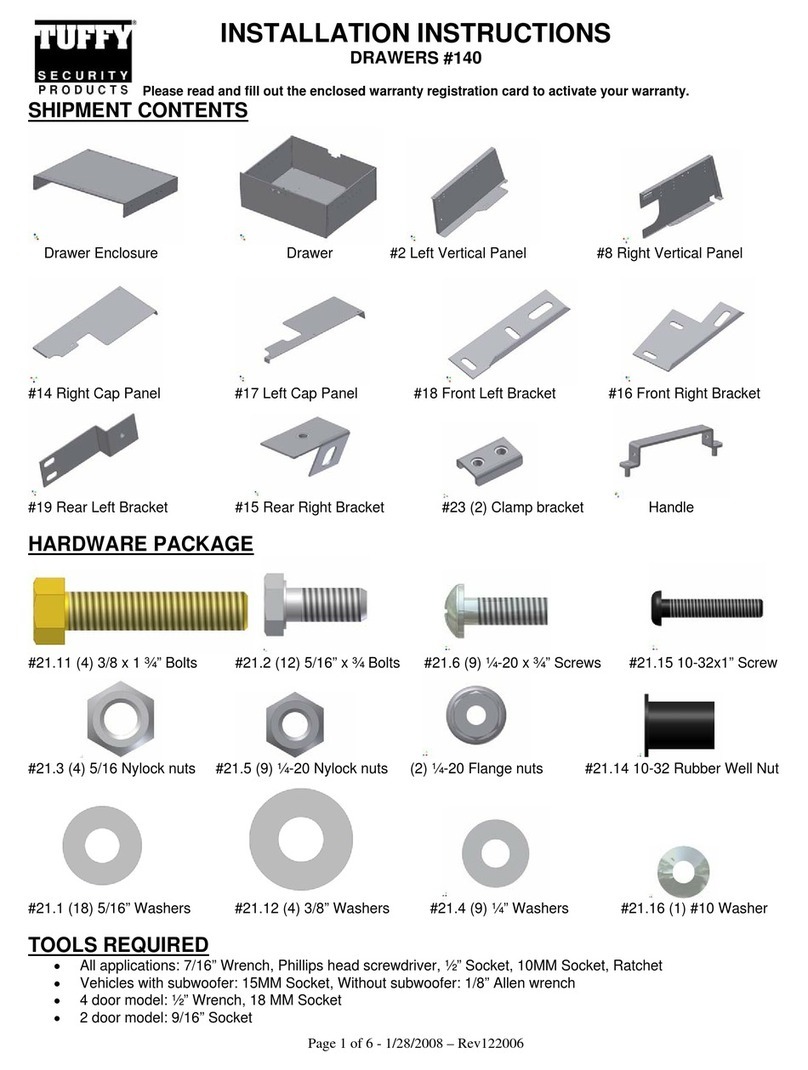
Tuffy
Tuffy 140 installation instructions
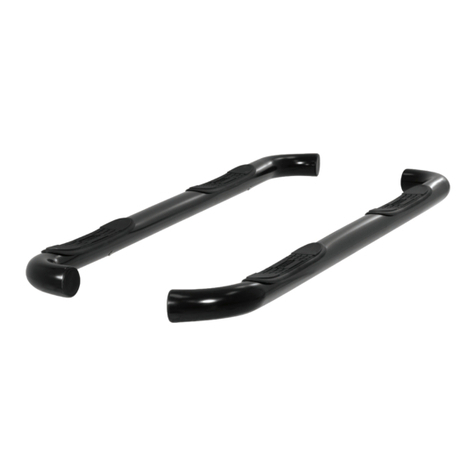
Aries
Aries 203016 installation manual
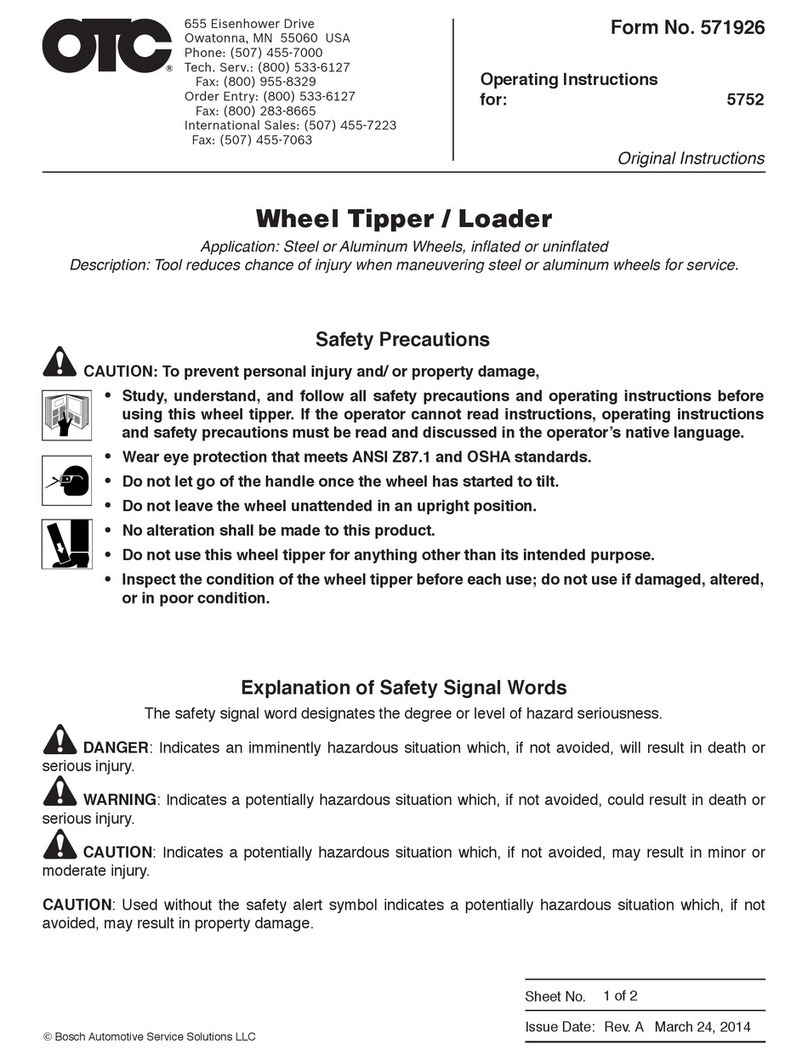
OTC Tools
OTC Tools 5752 operating instructions
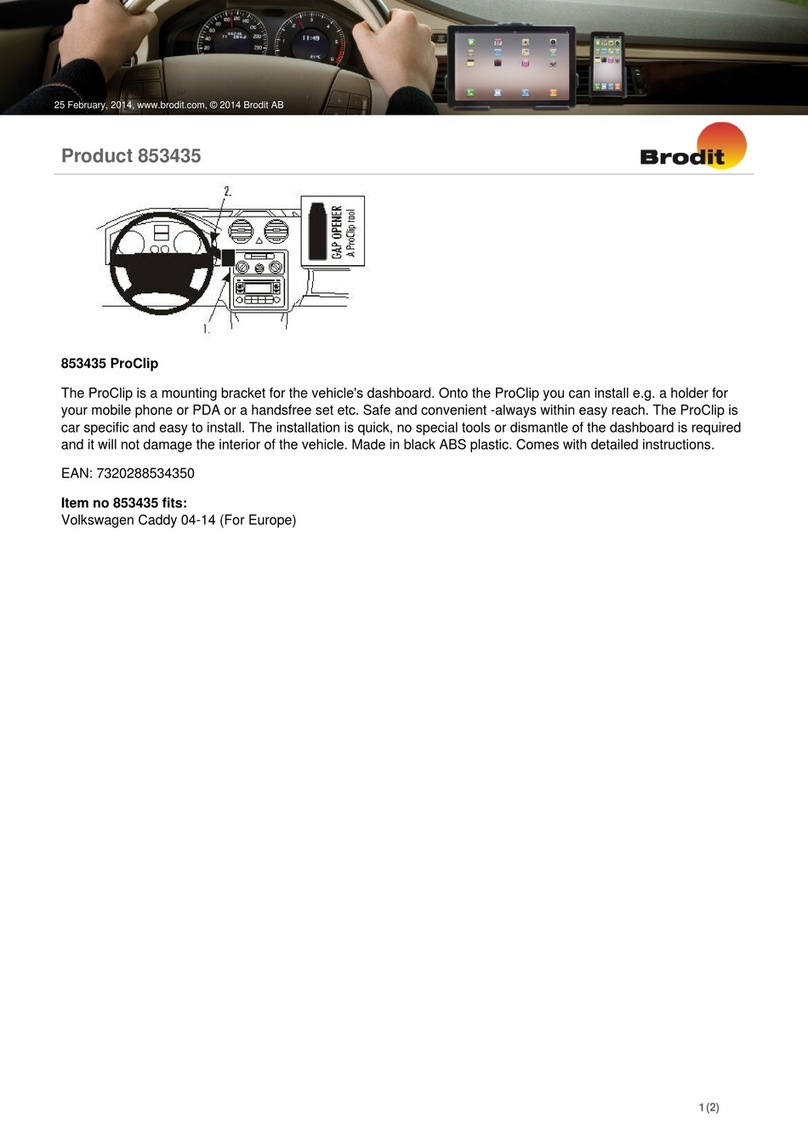
Brodit
Brodit ProClip 853435 installation instructions

Westfalia
Westfalia 304 204 300 113 Installation and operating instructions
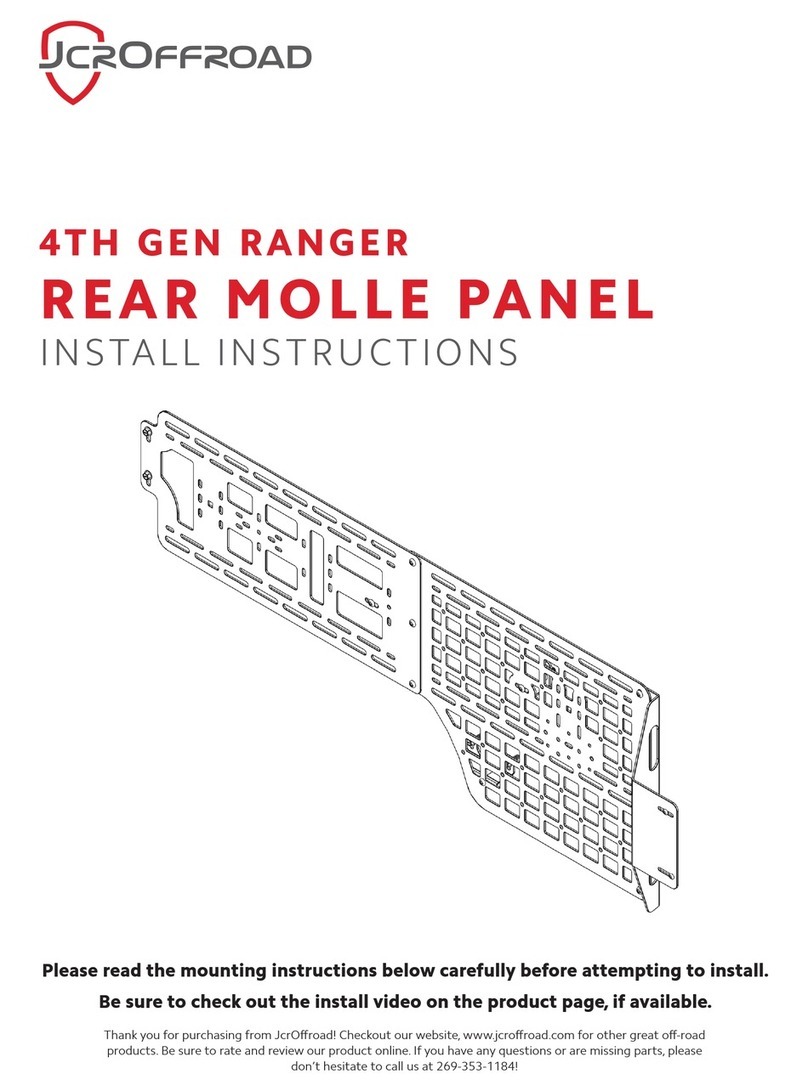
JCROffroad
JCROffroad REAR MOLLE PANEL Install instructions
